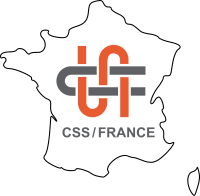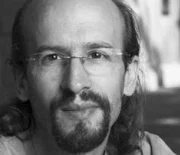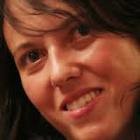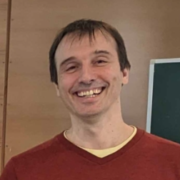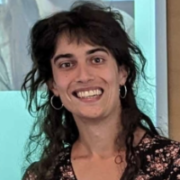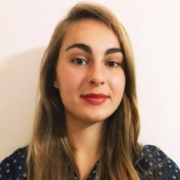ELSA ARCAUTE
University Collage London, UK
A multiscalar approach to urban accessibility and resilience.
Abstract
Urban systems, as complex adaptive networks, exhibit interdependencies and heterogeneous patterns of connectivity and accessibility. These characteristics give rise to hierarchical structures, where structural changes emerge at distinct scales. In this talk, we propose a multiscalar, relational framework for detecting these shifts and identifying scale-specific vulnerabilities in accessibility. This work reveals leverage points for targeted, resilience-oriented interventions.
ALAIN BARRAT
CNRS / Centre de Physique Théorique / Turin Center for Living Systems, Marseille, France
Feeding contact data into models of epidemic spread for actionable insights
Abstract
Computational models offer a crucial setting to test strategies to mitigate the spread of infectious diseases, providing useful insights to applied public health. To be actionable, models need to be informed by data that describe the structure of interactions between individuals. While data coming from different sources and at different resolutions have become increasingly available, their integration into computational frameworks poses a number of challenges.
I will first give an example of how high resolution data sets can be used to build realistic agent-based models, suggest, evaluate and compare various mitigation strategies. As such detailed data sets are however rarely available, I will also discuss whether models fed with less detailed data lead to the same actionable conclusions. Finally, while most studies focus on how the structure of contacts shapes the spread of a disease, I will address a reverse question: do different spreading processes unfolding on a network lead to the same propagation patterns? This has consequences in the role of models in decision-making, as many results on propagation patterns and on the identification of structures with high spreading power or to monitor in surveillance programs are typically obtained using very simplified contagion processes. Our results imply in particular that numerical simulations using simplified settings can bring important insights even in the case of a new emerging disease whose properties are not yet well known. I will conclude with some perspectives on new avenues in the modeling of spreading phenomena.
HUGUES BERSINI
FARI Institute of AI for the public goods, director of the IRIDIA AI Laboratory, Université Libre de Bruxelles, Belgium
What biology can teach us about the concept of "Identity"
Abstract
Lorsqu’on s’intéresse de près aux phénomènes biologiques, mon exposé montrera que des notions comme la stabilisation dans le temps et dans l’espace d’un système dynamique, sa préservation et sa viabilité, son individuation avant même l’apparition d’un génome unique, la diversité de ses composants, l’ouverture et la métabolisation des intrants, le processus d’acceptation et celui de rejets des impacts extérieurs à même de le déstabiliser, le regroupement spontané de plusieurs composants afin d’améliorer encore l’adaptation du tout et les conflits qui peuvent apparaître entre ces regroupements pour des ressources convoitées, peuvent faire comme un écho aux discussions et disputes que le concept d’identité provoque cette fois dans l’univers des sciences humaines. Cet exposé sera aussi un hommage à Francisco Varela dont les recherches à Paris s’étaient envolées dans toutes les directions, démontrant une volonté constante et farouche de réimprimer l’humain dans sa biologie, son esprit au cerveau et au vivant, la maladie à la déstabilisation d’un réseau immunitaire, et aussi de questionner cette notion d’identité, autant dans ses expériences de vie et de méditation qu’au cœur même de ses recherches, m’offrant au passage de l’accompagner dans certaines d’entre elles.
YAMIR MORENO
Director of the Institute for Biocomputation and Physics of Complex Systems (BIFI), Zaragoza, Spain
Social Dilemmas via Generative Agent-Based Models
Abstract
Current Large Language Models (LLMs) have opened new avenues for modeling complex social dynamics. In particular, LLM-driven agents provide a unique opportunity to explore several phenomena in artificial societies. Admittedly, recent advancements have demonstrated that LLMs can exhibit human-like behaviors, including cooperation, fairness, and adherence to social norms. However, they also present significant challenges, such as sensitivity to prompt design, hallucinations, and inconsistencies in decision-making. In this talk, we discuss the capacity of GABMs to reproduce behavioral experiments and compare findings on cooperation and reputation dynamics in human groups with those obtained by implementing a reputation-based game in which LLM-driven agents played the Prisoner’s Dilemma on dynamics networks. Our results indicate that LLM-based agents can partially reproduce human cooperative behavior and network dynamics, though important limitations remain. These models will become increasingly integrated into decision-making processes, thus, understanding their constraints and interaction patterns with humans and artificial agents is crucial.
CAMILLE ROTH
CNRS & EHESS, Centre d’analyse et de mathématique sociales, Paris, France
Echo chambers, filter bubbles? it depends
Abstract
FLAMINIO SQUAZZONI
Professor of Sociology, Department of Social and Political Sciences, University of Milan
Exploring the pros and cons of open peer review in academic journals with computational social science methods
Abstract
tba
Website
ELISA THÉBAULT
CNRS, Institut d’écologie et des science de l’environnement, Paris, France
Species diversity, food web structure and ecosystem stability: bridging the gap between theory and data?
Abstract
The consequences of diversity and food web structure on the stability of ecological communities have been debated for more than 5 decades. While the understanding of the relation between diversity and the stability of properties at community and ecosystem levels has gained from joint empirical, experimental and theoretical insights, the question of the relation between food web structure and stability has received almost exclusively theoretical attention. The lack of empirical studies on this issue is partly due to the fact that theoretical studies are often disconnected from the stability of natural ecosystems, and to the difficulty of describing and manipulating food web structure in the field. Here I will present results based on both theoretical food web models and data analyses of time-series of fish communities across France, aiming to investigate in parallel the relations between diversity, food web structure and the stability of ecosystem properties.
Website
Invited Speakers
GUILLAUME BESLON
INSA Lyon, France
Structural mutations set an equilibrium non-coding genome fraction
Abstract
Genome complexity greatly varies among the different organisms and is still an unsolved mystery. In particular, the evolution of non-coding genome size is still poorly understood: While some fraction of non-coding DNA has arguably a regulatory function, a large part does not seem to have a detectable impact on any phenotypic trait and the abundance of non-functional DNA in genomes, observed across the Tree of Life, challenges a purely adaptationist explanation. In this talk, I will present several computational and mathematical models we build to study the dynamics of non-coding sequences in the presence of various kinds of mutational events including substitutions, InDels and structural variants. I will show how the non-coding fraction of the genome is shaped by two factors: unavoidable biases in the neutrality of the different mutation types and the robustness selection imposed by the mere existence of structural variants. I will show how these two factors together ensure the existence of an equilibrium non-coding fraction and that — at least in the models — this equilibrium depends solely on the product of population size and mutation rate.
GIULIA CENCETTI
Université Aix Marseille, Université de Toulon, France
Temporal network and hypergraph generation: from small to large scale in time and topology
Abstract
Analysing temporal networks and hypergraphs to generate realistic surrogates induces us to reflect about the set of intrinsic relationships that shape an evolving network. These involve temporal and topological causalities and correlations concerning nodes activity and hyperedges appearance. We observe how the individual nodes dynamics is linked to that of neighbouring nodes but is also influenced by the global topology. Analogously, the local topology at each time is affected both by the interactions of the few previous time steps and by long-term temporal correlations. In this context we develop a framework to generate temporal networks and hypergraphs, both based on the observation of real-world temporal networks given as input. This methodology will allow to obtain surrogate temporal networks or hypergraphs to replace real data when the latter are not usable or sharable (particularly useful for social data, often subject to privacy issues). It additionally provides an important tool for data augmentation, allowing us to generate temporal networks with an arbitrary number of nodes and time span, using as input original patterns extracted from available datasets of limited size. The versatility of the obtained methods allows us to combine multiple input temporal networks, for instance different social contexts, thus simulating a complete society resulting from the integration of different social settings (e.g., schools, workplaces, hospitals, etc.). This represents an additional mechanism to overcome the incompleteness of original data.
GUILLAUME DEFFUANT
INRAE, Clermont Ferrand
How opinions get more extreme in an age of information abundance
Abstract
We live in an age of information abundance but know little about how this influences our opinions or attitudes. A common expectation is that people consulting numerous pieces of information, well balancing the different sides of an issue, will adopt a moderate attitude about the issue. We claim that this expectation is deceitful and suggest that, on the contrary, people tend to get extreme and dogmatic. The cause for this extremization is a hardening confirmation bias—when their attitude gets more extreme, people get more likely to ignore information that differs from their views. Our claim is supported by simulations of two fundamentally different computational models of an agent consulting information and holding a hardening confirmation bias. For both models, the initially moderate attitude of the agent tends to get extreme when the agent consults abundant unbiased information, while it remains moderate when consulting limited information. We analyze the extremization pathways displayed in the models and discuss how our results may affect views on polarization and on the role of online media.
Website
BENJAMIN FAGARD
CNRS Lattice Laboratory ENS
Identifying Language Change in a Corpus – A Frequency-Based Model
Abstract
The existence of large language models makes it possible to imagine new ways of looking at language change. But much can still be done by using existing language corpora and models of language change. For instance, looking at changes in frequency alone, it has been shown that it is possible to identify ongoing language change, e.g. the competition between variants, which displays a characteristic ‘s-curve’. This concept is anything but new (Osgood & Sebeok 1954, Kroch 1989), but has been recently refined theoretically with more explicit models (Blythe & Croft 2012, Feltgen et al. 2017, Feltgen 2024), and used to identify cases of language change in large corpora (Boukhaled et al. 2019). A crucial question in that respect is whether it can be used not only to identify language change, but to distinguish between different types of change (viz. lexical innovation, borrowing, calques, grammaticalization). In my talk, I will address this question with data from large diachronic corpora.
References
Blythe, R. A. & W. Croft. 2012. S-curves and the mechanisms of propagation in language change. Language 88(2), 269-304.
Boukhaled, M.A., Fagard, B. & T. Poibeau. 2019. The Dynamics of Semantic Change: A Corpus-Based Analysis. Lecture Notes in Artificial Intelligence 11978, 1-15.
Feltgen, Q., B. Fagard & J.-P. Nadal. 2017. Frequency patterns of semantic change: Corpus-based evidence of a near-critical dynamics in language change. Royal society open science.
Feltgen, Quentin. 2024. Is language change chiefly a social diffusion affair? The role of entrenchment in frequency increase and in the emergence of complex structural patterns. Front. Complex Syst. 2:1327425.
Kroch, Anthony S. 1989. Reflexes of grammar in patterns of language change. Language variation and change 1(3), 199–244.
CLAIRE LAGESSE
CNRS, Théma, Université Bourgogne Franche-Comté, France
From understanding road network patterns to modeling their evolution
The patterns and logic of urban morphology result from complex processes that can be understood by identifying characteristics of the spatial structure. The intricate organization of this structure reveals an underlying order in urban evolution. Road networks are among the urban components that endure over time, presenting a challenging yet fascinating subject for study. Graph theory provides a mathematical formalization of road networks, thereby enhancing our spatial understanding.
Our research takes an analytical approach to urban morphology, focusing on road networks and emphasizing the historical context and structural features induced by their physical layout. Our research unfolds in four stages:
(1) Identifying a relevant element with which to analyze road networks (‘the Way’).
(2) Finding indicators with which to characterize the structure of road networks and reveal common properties over space and time.
(3) Pinpointing morphotypes within the road network associated with morphological evolution processes.
(4) Proposing a simulation model (“WayMorph”).
Our findings reveal that urban morphology is the result of complex processes that can be identified by analyzing spatial structure. Understanding urban morphogenesis and past evolution is pivotal for addressing future developmental challenges and informing the decision-making of city stakeholders. The choices made regarding territorial development, as reflected in road network morphologies, influence disparities in accessibility and territorial development dynamics. Thus, a profound understanding of the morphology and dynamics of road network evolution can significantly support territorial planning.
Abstract
tba
PEDRO RAMACIOTTI MORALES
Complex Systems Institute of Paris & Médialab, Sciences Po
Reading world politics through social media
Abstract
Concerns about public online spaces have fuelled numerous studies on social media and algorithms. One leading type of concern regards phenomena such as informational segregation or polarisation. Numerous studies have addressed these questions at national level and on different platforms, but essential questions remain unanswered regarding the measurement and prevalence of these phenomena. One outstanding challenge is the comparative measurement of polarisation in reference frames that can be applied across national settings and time-frames. In this talk I explore how conceptual frameworks from sociology and political science–that have guided decades of advances in survey-based research–extend to the study of these online spaces, enabling the study of polarisation in multidimensional issue and ideology space, and on a multitude of countries and settings, from the study of algorithmic recommendation, to media outlet ecosystems, and online political mobilisation.
AGNIESZKA RUSINOWSKA
CNRS, CES, PSE, Université Paris 1, Paris, France
Network-based approach to environmental decision-making and allocating emission responsibility
Abstract
The aim of this talk is to provide a short overview of network-based and game-theoretic approaches to environmental decision-making. Their methodology based on cooperative game theory solutions and concepts from network theory have been applied, in particular, to supply chain management, cost-sharing problems in the context of river management, loss allocation in energy transmission networks, allocation of forest resources, responsibility in the context of hazardous transportation problems, allocation of the global carbon budget or carbon emission permits, and in the context of carbon tax reforms, among others. We are particularly interested in the problem of defining responsibility for greenhouse gas emissions which is a key issue in view of developing efficient climate regulation and monitoring its implementation. In this talk, I will focus on an axiomatic approach to measuring greenhouse gas emissions in production networks, addressing the issue of environmental responsibility both from theoretical and empirical points of view (van den Ende, Mandel and Rusinowska, 2025)
Invited – PhD Award 2025
Brandao Eduardo
Physique (applications systèmes complexes)
A measure of dynamic complexity of self-organized systems
Abstract
Complexity is easy to recognize but difficult to define. In my thesis, I used a physics-informed machine learning framework under low-data, partial-knowledge conditions to show that self-organization drives the formation of regular nanometric surface patterns under femtosecond laser irradiation. To build on this work, it is crucial to establish a precise link between complexity and self-organization. In this talk, I present a novel measure of dynamic complexity for self-organized systems that integrates dynamical diversity and connectivity. This metric is straightforward to implement, efficient to compute, and applies across scales — from convective nanometric patterns to the large-scale structures of the universe — demonstrating its versatility and intuitive appeal, potentially across disciplines.
biography
PhD, Laboratoire Hubert Curien (2023, Saint-Étienne, France). Assistant Professor, Université Jean Monnet & Laboratoire Hubert Curien. Member of the Inria MALICE project team.
Chomel Victor
Data science / sociologie
Au-delà des Fake News : une approche structurelle et dynamique des manipulations de l’information
Abstract
Ma thèse a porté sur l’étude de la désinformation avec une approche structurelle et dynamique. L’approche retenue consiste à s’intéresser au contexte plus qu’aux contenus, permettant d’appliquer les outils à des sujets divers. L’objectif est de montrer comment l’analyse de la circulation de l’information ainsi que sa mise en relation avec les structures sociales permet la détection de comptes et de communautés ayant des comportements anormaux ou inauthentiques sur les réseaux sociaux. Les études portent principalement sur trois datasets de Twitter, collectés au cours des dernières années : réchauffement climatique, politique française et vaccination.
Biography
Victor a fait sa thèse sous la direction de David Chavalarias. Ses travaux portent sur l’étude des manipulations de l’informations en ligne à partir de modélisations tirées de l’étude des graphes.
El Gouj Hanae
Morphogénèse et géographie urbaine
Analyzing the structural properties of road networks to model their morphogenesis
Abstract
Urban morphology results from complex processes, the patterns and logic of which can be deciphered by identifying characteristics of the spatial structure. The complex organization of this structure suggests the presence of an underlying order in urban evolution. Among the urban components, road networks endure through time, and present a challenging yet fascinating subject for study. Graph theory offers a mathematical formalization of road networks, enhancing spatial understanding.
Our research approaches urban morphology through an analytical lens focused on road networks, emphasizing historical context and structural features induced by their physical layout. It unfolds in three axes: (1) morpho-historical analyses of road networks in Dijon, Besançon, and Pontarlier, over time, revealing common structural properties ; (2) identification of morphotypes within the road network, associated with morphological evolution processes ; and (3) proposing simulation model, namely “WayMorph”.
The fundings reveals that urban morphology is the result of complex processes that can be identified by analyzing spatial structure.Understanding urban morphogenesis and past evolution is pivotal for addressing future developmental challenges, aiding decision-making for city stakeholders. Territorial development choices, reflected in road network morphologies, reciprocally influence accessibility disparities and territorial development dynamics. Profound comprehension of road network evolution dynamics can significantly support territorial planning.
Biography
PhD (2023) and currently a research associate at ThéMA Laboratory (Besançon)
https://thema.univ-fcomte.fr/page_personnelle/hanae
Jeammet Sélènne
Morphogénèse de réseaux dans l’argile
Ruptures enlacées - Morphogénèse de réseaux dans l’argile
Abstract
Certaines argiles ont la propriété de gonfler quand elles sont humidifiées. Quand ces argiles se dessèchent, par évaporation à la surface en contact avec l’air, elles cherchent alors à se rétracter. L’argile à la surface va se déformer, augmentant les contraintes, jusqu’à un seuil de rupture, où des craquelures apparaissent pour relaxer les contraintes accumulées dans le matériau. Ces craquelures se propagent, interagissent, se rencontrent, et finissent par former une structure complexe de réseau spatial à la surface.
Ces structures rencontrées dans les sols peuvent être reproduites en laboratoire, en laissant une couche d’argile mince, initialement humidifiée, se dessécher sur des plaques de verres, en faisant varier les conditions expérimentales (épaisseur, type d’argile, humidité de l’air, température) et en observant les variations de motifs occasionnées. Ce système est peu coûteux, et permet d’obtenir des motifs variés dont on peut suivre l’évolution sur des temps raisonnables. Il constitue donc un système pratique pour l’étude de l’apparition de réseaux spatiaux, dans la continuité de travaux sur ces structures apparaissant dans d’autres systèmes, comme les veines des frondes de fougères, les rues dans les villes, les squelettes de coraux.
Dans une approche morphogénétique, on a proposé de comprendre l’apparition de ces motifs par la propagation locale des craquelures. Pour se faire, on a construit un modèle phénoménologique du système, basé sur nos observations des expériences, en modélisant les ingrédients minimaux qui composent ce système et lui donnent sa complexité. De ce modèle, on a dérivé une loi de vitesse pour les craquelures, qui permet de simuler des trajectoires et comportements observés dans les expériences. Par des bifurcations de ces comportements, on peut ainsi remonter de l’échelle locale aux motifs globaux, et ainsi comprendre, par l’histoire et les conditions de la croissance, l’émergence des différents types de motifs observés. Ce travail se termine par une ouverture vers les autres systèmes physiques exhibant des structures de réseaux spatiaux en deux dimensions, en adaptant le modèle construit pour les craquelures à ces systèmes. On a ainsi proposé une classification des structures de réseaux spatiaux en fonction du type de potentiel dans lequel ces réseaux croissent, en exhibant notamment la possibilité de transitions entre réseaux réticulés et non-réticulés, traditionnellement perçus comme qualitativement distincts.
Biography
Josserand Mathilde
Dynamiques du langage
Language evolution in heterogeneous groups
Abstract
A person who perceive the blue color differently from their peers might also describe it differently, and over time, these subtle individual differences can reshape how the whole group talks about colors. But how do such individual variations influence the emergence of shared communication systems? In this talk, I explore how differences in language production and perception can influence how languages evolve. To test this, we conducted a laboratory experiment in which small groups of four participants developed a shared language, with one participant deliberately biased in their communication. Then, we also used Bayesian agent-based models to explore how a shared language emerges in heterogeneous groups, and how the structure of the communicative networks influences these dynamics. The results challenge the common assumption that ‘majority rules’ and suggest that languages are adjusted to the unique characteristics of their speakers, even if they are in the minority. My goal is to bring a nuanced understanding of language evolution, treating variation as valuable data rather than mere noise.
Biography
Cognitive scientist exploring language evolution & cross-cultural psychology. PhD from the Laboratoire Dynamique du Langage (2023; Lyon, France), currently a postdoctoral researcher at Université Laval (Québec, Canada). Publications: https://scholar.google.com/citations?user=2J4Nk5MAAAAJ&hl=fr
